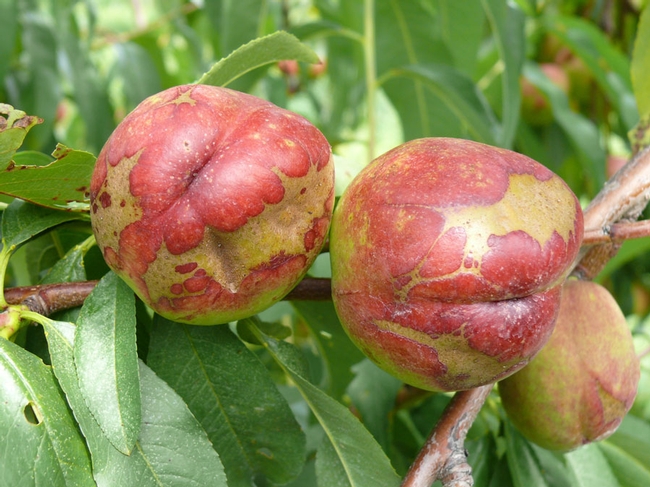Brent McGhie, Butte County Master Gardener, February 3, 2017.

Western flower thrips are tiny insects. Adults are only 0.8 – 1.4 mm long. They range in color from dark brown in the spring to a lighter white and yellow form that is prevalent during the rest of the year. They are hard to spot because of their minute size and their habit of sheltering inside flower and leaf bud scales. Thus, a history of thrips-damaged fruit may be a better indicator of the presence of thrips than actually seeing them.
The tan or silvery, scabby scarring caused by thrips does not significantly harm the internal quality of the nectarine fruit, but the scarring is unsightly and has a coarse, leathery texture that is unpleasant to bite into. Fruit damage occurs when immature thrips nymphs feed on the surface of tiny fruit, just as it begins to develop. Feeding creates scars on the fruit surface and these scars enlarge as the fruit grows. These insects often begin feeding even before the flower petals have dropped from the newly forming fruit. Once fruits begin to enlarge and their skin becomes tougher, thrips start to feed on new tender leaves as leaf buds begin to open. Unfortunately, this means that by the time their damage is apparent, thrips may no longer be present on the fruit.
Western flower thrips are not easy to control. They overwinter as adults in weeds and grasses beneath fruit trees or in nearby fields. If these overwintering sites are disturbed (by mowing or cultivating, for example), the thrips have a tendency to migrate onto nearby fruit trees. The first line of defense in controlling thrips is to keep the area around fruit trees clean and weed free in the first place. If possible, nearby fields should be disked or mowed in the fall to further deny thrips a habitat for overwintering.
Another way to control thrips is to encourage their natural enemies. Green lacewings, predatory thrips, minute pirate bugs and tiny predatory wasps are among the beneficial insects that prey on western flower thrips. To encourage these beneficials, keep dust to a minimum and consider rinsing dust off plants. Also, avoid persistent pesticides because these chemicals harm beneficials as well as the targeted pests. In addition, it should be noted that the greater the diversity of plant species in the garden, the greater are the odds of providing a suitable habitat for beneficials. A final thing to note about biological control is that releasing natural enemies is unlikely to provide significant thrips control. In most situations, beneficials simply disperse soon after they are released.
If the cultural and biological controls described above do not provide adequate control, they can be used in conjunction with the most selective, least toxic insecticides available. Contact insecticides that do not leave persistent residues include insecticidal soaps, horticultural oils and neem oil. These oil sprays must thoroughly cover the affected trees and be used at the right rates to avoid phytotoxicity (toxic effects on plant growth). These products can also be harmful to natural enemies and pollinators, so the timing of their application is important. For example, spraying just after flower petals have dropped will limit how much exposure bees will have to these materials.
A somewhat more effective spray is spinosad, which is sold as Captain Jacks' Deadbug Brew, Green Light Lawn and Garden Spray with Spinosad 2, or Monterey Garden Insect Spray. Spinosad is toxic to certain natural enemies and to bees, so should not be sprayed when trees are flowering. As with any chemical control, be sure to read and carefully follow label directions. Avoid using organophosphates such as malathion, as well as carbaryl, or pyrethroids as these chemicals are highly toxic to beneficial insects and are not particularly effective against thrips.
For further information:
- UC IPM: Nectarine: Western Flower Thrips
- UC IPM: Pest Notes: Thrips
- OnTario Tender Fruit IPM: Western Flower Thrips
Photo credit: OnTario Tender Fruit IPM